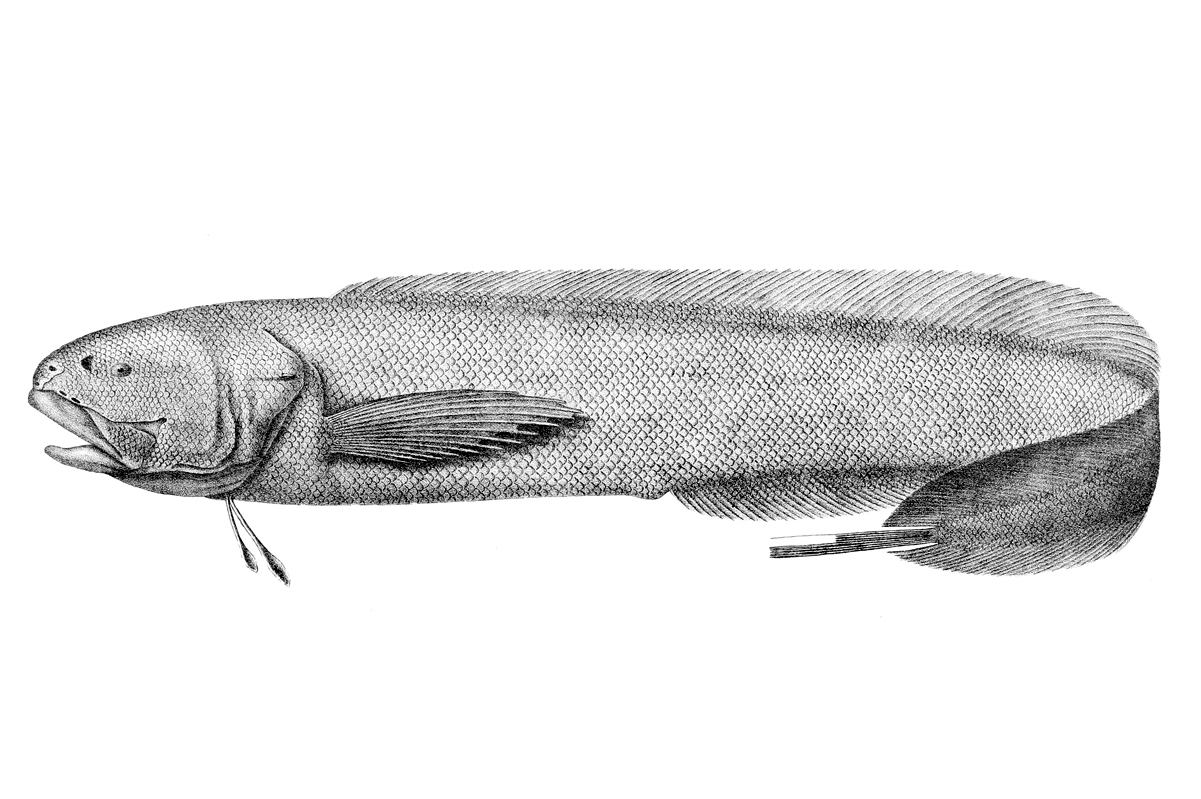Holcomycteronus brucei (Dollo 1906)

Illustration of the cuskeel Holcomycteronus brucei. Source: From: Regan 1913 Antarctic fishes of the Scottish National Antarctic expedition. License: Public Domain
Summary:
A rare pale pinkish deepwater cuskeel with a blueish head, black margins on the dorsal and anal fins, and the outer half of the pectoral fin dark brown. The species has a rounded snout, a small eye, a strong opercular spine and an indistinct lateral line.
Cite this page as:
Bray, D.J. 2022, Holcomycteronus brucei in Fishes of Australia, accessed 10 Jul 2025, https://fishesofaustralia.net.au/Home/species/2746
Holcomycteronus brucei (Dollo 1906)
More Info
|
Distribution |
Off southern Tasmania. Elsewhere the species occurs in waters of Antarctica and the Southern Ocean: French Southern Territories (Crozet Is.); South Georgia and the South Sandwich Islands (South Georgia). |
|
Features |
Vertebrae 19–20 + 50–52 = 70–71; Dorsal fin 104– ca. 123; Anal fin 95–98; Caudal fin 8; Pectoral fin 18–19; Pelvic fin 2; Gill rakers 5 + 1 + 15; branchiostegal rays 8; pseudobranch filaments 2. Body robust; snout rounded; eye diameter much shorter than snout; opercular spine strong; 2 median and a pair of basibranchial tooth patches; 7-11 developed rakers on anterior gill arch; pelvic fin rays flattened distally and somewhat thicker in males. |
|
Etymology |
The species is named in honour of William Speirs Bruce, a Scottish oceanographer and leader of the Scottish National Antarctic Expedition (1902-1904), during which the holotype was collected. |
|
Species Citation |
Neobythites brucei Dollo, 1906, Proc. Roy. Soc. Edinburgh 26(3): 177. Type locality: Weddell Sea, Antarctic, 67°33'S, 36°35'W, depth 2500 fathoms. |
|
Author |
Bray, D.J. 2022 |
|
Resources |
Holcomycteronus brucei (Dollo 1906)
References
Anderson, M.E. & Stein, D.L. 2006. Redescription of the rare ophidioid fish, Holcomycteronus brucei, from two new specimens from the Southern Ocean. Polar Biology 29: 640-642 https://doi.org/10.1007/s00300-005-0100-7
Cohen, D.M. & Nielsen, J.G. 1978. Guide to the identification of genera of the fish order Ophidiiformes with a tentative classification of the order. National Marine Fisheries Service (U.S.). Technical Report 417: 1-72 figs 1-103
Dollo, L. 1906. Neobythites brucei, poisson abyssal nouveau recueilli par l'Expédition Antarctique Nationale Ecossaise. Note préliminaire. Proceedings of the Royal Society of Edinburgh 26(3): 172-181 See ref online
Nielsen, J.G. 1990. Ophidiidae. in Gon, O. & Heemstra, P.C. (eds). Fishes of the Southern Ocean. Grahamstown : J.L.B. Smith Institute of Ichthyology 462 pp. See ref at BHL
Nielsen, J.G. 1999. A review of the genus Neobythites (Pisces, Ophidiidae) in the Atlantic, with three new species. Bulletin of Marine Science 64(2): 335-372 See ref online
Nielsen, J.G., Cohen, D.M., Markle, D.F. & Robins, C.R. 1999. Ophidiiform Fishes of the World. An annotated and illustrated catalogue of pearlfishes, cusk-eels, brotulas and other ophidiiform species known to date. FAO Fisheries Synopsis No. 125 Vol. 18. 178 pp. See ref online
Nielsen, J.G., King, N.D. & Møller, P.R. 2008. Rare abyssal, ophidiid fishes from off the Crozet Islands, Southern Ocean, with a new species of Apagesoma Carter, 1983. Cybium 32(1): 43-50 See ref online
Regan, C.T. 1913. Antarctic fishes of the Scottish National Antarctic Expedition. Transactions of the Royal Society of Edinburgh 49(2)2: 229-292 figs 1-6 pls 1-11 See ref at BHL
Uiblein, F., Everett, B., Matiku, P. & Sithole, Y. 2020. Holcomycteronus brucei. The IUCN Red List of Threatened Species 2020: e.T137551403A137564070. https://dx.doi.org/10.2305/IUCN.UK.2020-1.RLTS.T137551403A137564070.en. Accessed on 07 October 2022.

